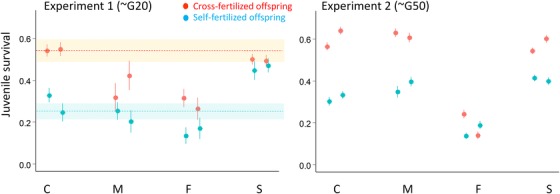Figure 1.

Juvenile survival in the two experiments, for each line and experimental treatment (red: outcrossing, blue: selfing). The average values are given together with their SE over individuals, the two replicates are represented separately for each line type. The relative difference in survival between outcrossed and self‐fertilized offspring represents inbreeding depression (δ). The values of δ ± SE for each line type and each experiment are C: 0.46 ± 0.10 (1st expt) and 0.47 ± 0.08 (2nd expt), F: 0.49 ± 0.15 and 0.16 ± 0.34, M: 0.40 ± 0.13 and 0.40 ± 0.06, and S: 0.08 ± 0.12 and 0.28 ± 0.06. We did not measure juvenile survival in the founding G0 population common to all lines. However, we were able to retrieve from a previous study [48] data on the juvenile survival of first‐generation self‐fertilized and cross‐fertilized offspring from 7 of the 10 natural populations that were used to constitute the founding population. The means ( ± SE across populations) were respectively: 0.544 ± 0.054 and 0.251 ± 0.038 (indicated by dashed lines and shaded areas in the left panel), with an inbreeding depression of δ = 0.524 ± 0.077.
